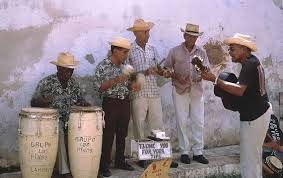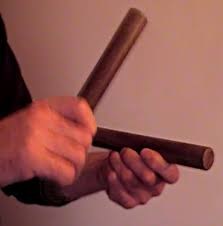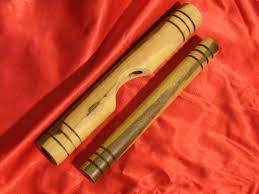
Claves are a pair of cylindrical hardwood sticks belonging to the hand percussion family of musical instruments. Traditional Claves are made of rosewood, ebony or granadilla whereas modern Claves are made of fibreglass or plastic. Claves can also be grouped under the concussion idiophones type. With Claves, one stick is held in the player’s fingertips like a bow or a cue while the other is held in the palm and is the resonator. One of the Clave stick is hollow and is carved in the middle, which amplifies the clicking sound. A part of the original Afro–Cuban music, Claves as a musical instrument became more prominent during the period when the use of drums was banned. Claves are the kind of musical instruments that maintain various fixed rhythms and are usually found as accompaniments in the Latin–American dance bands. Ancient musical instruments, the Claves were used in many cultures as part of rituals, in calling attention of as well as to create musical rhythm. Claves is the backbone of Latin, Cuban, African and Brazilian music. Let us learn more about this instrument.
As a musical instrument, Claves have an interesting origin. The port of Seville was the origin of a shipbuilding activity in 1492. Most of the forests around Seville had been deforested and as a result, the Spanish had to shift the shipbuilding to Cuba. The Spanish found the Cuban wood superior in quality. Instead of nails, pegs were used to fasten planks of wood. African slaves, whom the Spanish Moors had brought to work as labour had been deprived of their drums. Remembering their music, one of them picked up two discarded pegs of hardwood and struck them together. A loud, sharp and penetrating sound was produced. The Africans started polishing these sticks into rhythmic musical instruments. Claves have become an important part of Cuban, African and Brazilian music since then. The Havana based rumba dance incorporated the Clave rhythm during the 19th century. Around 1910, the Claves rhythm was adopted by the Son and Guaguanco traditional dances of Cuba. The basic Son ensemble of the 20th century Havana consisted of Claves along with the other musical instruments.

Traditionally, the Claves are short, fat sticks made of wood, which are called dowels. Out of the two, one of them is the resonator. The technique is to hold one lightly between the thumb and the first two fingers with the palm up. The other Clave is held in the striking hand with a firm grip as if holding a drum stick. With this Clave in the striking hand, the Clave in the resting hand is struck in a rhythmic pattern in the centre. The striking Clave is called ‘el macho’ (male) whereas the resting clave is called ‘el hembra’ (female). These terms are used even if the Claves are identical. A roll can be achieved by alternating pressure of the two fingers, which also enables movement of the Clave back and forth. A bright clicking sound is produced when struck.

Claves are made of two wooden sticks; one of them is with a hollow indented centre.

The rhythmic pattern of the Claves is used to set the tempo of Afro–Cuban music as well as dance forms such as rumba, salsa, comparsa, son, mambo, Latin jazz, songo and timba. The five–stroke Clave pattern (3+2 or 2+3) forms the base of Afro–Cuban rhythms. This pattern, originated in Sub–Saharan African music is the base that holds the rhythm together and is also found in the African Diaspora music, Haitian Voodoo drumming, Brazilian music and as a rhythmic decoration in the North American popular music.

The Claves as musical instruments consists of two sticks. Sound is made by striking one stick against the other. In the traditional Cuban style of playing the Claves, one stick is held in the palm of the left hand. It is struck by the other stick held in the right hand. Experiments with the sounds of Claves can be done in a different ways. One has to hold the sticks tightly, holding them higher and lower thus, letting the sticks resonate for longer. Variations in tones can be produced by such experiments. These steps can be followed to play the Claves effectively. Playing of Claves can be learnt from traditional players of the instrument.
G Kowledge of | 0 Comments >>
0 Comments
Leave Comment
Your email address will not be published. Required fields are marked.